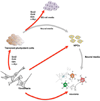Induced neuronal cells: how to make and define a neuron
- PMID: 22136927
- PMCID: PMC4377331
- DOI: 10.1016/j.stem.2011.11.015
Induced neuronal cells: how to make and define a neuron
Abstract
Cellular plasticity is a major focus of investigation in developmental biology. The recent discovery that induced neuronal (iN) cells can be generated from mouse and human fibroblasts by expression of defined transcription factors suggested that cell fate plasticity is much wider than previously anticipated. In this review, we summarize the most recent developments in this nascent field and suggest criteria to help define and categorize iN cells that take into account the complexity of neuronal identity.
Copyright © 2011 Elsevier Inc. All rights reserved.
Figures




Similar articles
-
The Lived Experience of Autistic Adults in Employment: A Systematic Search and Synthesis.Autism Adulthood. 2024 Dec 2;6(4):495-509. doi: 10.1089/aut.2022.0114. eCollection 2024 Dec. Autism Adulthood. 2024. PMID: 40018061 Review.
-
Developing a role for patients and the public in the implementation of health and social care research evidence into practice: the PIPER study (Pathways to Implementation for Public Engagement in Research) realist evaluation protocol.Res Involv Engagem. 2025 Jul 14;11(1):80. doi: 10.1186/s40900-025-00728-w. Res Involv Engagem. 2025. PMID: 40660365 Free PMC article. Review.
-
Cestode larvae excite host neuronal circuits via glutamatergic signalling.Elife. 2025 Jul 4;12:RP88174. doi: 10.7554/eLife.88174. Elife. 2025. PMID: 40613653 Free PMC article.
-
Adapting Safety Plans for Autistic Adults with Involvement from the Autism Community.Autism Adulthood. 2025 May 28;7(3):293-302. doi: 10.1089/aut.2023.0124. eCollection 2025 Jun. Autism Adulthood. 2025. PMID: 40539213
-
"I Don't Understand Their Sense of Belonging": Exploring How Nonbinary Autistic Adults Experience Gender.Autism Adulthood. 2024 Dec 2;6(4):462-473. doi: 10.1089/aut.2023.0071. eCollection 2024 Dec. Autism Adulthood. 2024. PMID: 40018066
Cited by
-
Challenges in Physiological Phenotyping of hiPSC-Derived Neurons: From 2D Cultures to 3D Brain Organoids.Front Cell Dev Biol. 2020 Aug 26;8:797. doi: 10.3389/fcell.2020.00797. eCollection 2020. Front Cell Dev Biol. 2020. PMID: 32984317 Free PMC article.
-
Induced neural stem cells: a new tool for studying neural development and neurological disorders.Cell Res. 2012 Jul;22(7):1087-91. doi: 10.1038/cr.2012.73. Epub 2012 May 1. Cell Res. 2012. PMID: 22547025 Free PMC article. No abstract available.
-
Blood-Brain Barrier Alterations and Edema Formation in Different Brain Mass Lesions.Front Cell Neurosci. 2022 Jul 15;16:922181. doi: 10.3389/fncel.2022.922181. eCollection 2022. Front Cell Neurosci. 2022. PMID: 35910247 Free PMC article. Review.
-
Transdifferentiation: a new promise for neurodegenerative diseases.Cell Death Dis. 2018 Aug 6;9(8):830. doi: 10.1038/s41419-018-0891-4. Cell Death Dis. 2018. PMID: 30082779 Free PMC article. Review.
-
Synaptic protein and pan-neuronal gene expression and their regulation by Dicer-dependent mechanisms differ between neurons and neuroendocrine cells.Neural Dev. 2013 Aug 20;8:16. doi: 10.1186/1749-8104-8-16. Neural Dev. 2013. PMID: 23961995 Free PMC article.
References
-
- Banker GA. Trophic interactions between astroglial cells and hippocampal neurons in culture. Science. 1980;209(4458):809–810. - PubMed
-
- Bonfanti L, Olive S, Poulain D, Theodosis D. Mapping of the distribution of polysialylated neural cell adhesion molecule throughout the central nervous system of the adult rat: an immunohistochemical study. Neuroscience. 1992;49:419–436. - PubMed
Publication types
MeSH terms
Substances
Grants and funding
LinkOut - more resources
Full Text Sources
Other Literature Sources
Medical

